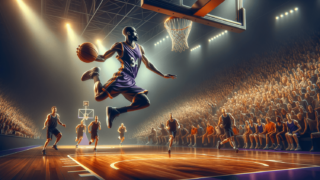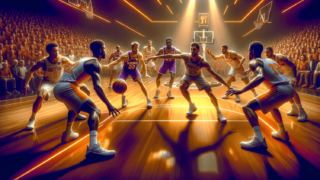
Ever wondered about the magic behind those lightning-fast moves on the basketball court? Well, buckle up, because we’re about to dive into the captivating world of the Give and Go. This simple yet highly effective basketball maneuver has dazzled spectators and frustrated defenders for decades. Whether you’re new to the game or a seasoned enthusiast, join us on this exciting journey as we unwrap the secrets of the Give and Go, providing you with the ultimate guide to mastering and appreciating this mesmerizing piece of basketball artistry.
What’s a Give and Go in Basketball?
A Give and Go in basketball is a fundamental offensive play where a player passes the ball to a teammate and immediately cuts to the basket, looking to receive a return pass for a scoring opportunity. This dynamic and effective maneuver relies on quick movement, precise passing, and strong communication between teammates to create space and exploit the defense.
Origin and Evolution of the Give and Go
In the earliest days of basketball, as the sport swiftly gained popularity, players and coaches strived to craft strategies that would give them an edge on the court. Although the specific origin of the Give and Go is uncertain, credit goes to early basketball pioneers who developed the motion offense and fundamentals that made such plays possible. Let’s dive into the beautiful dance of the Give and Go, its evolution, and its impact on modern basketball strategies.
Early Beginnings
The Give and Go may have inadvertently emerged with the invention of basketball by James Naismith in 1891. As the sport evolved, so did the strategies and the ways players moved on the court. The game’s early focus on passing, teamwork, and rapid movement brought the Give and Go to life—quickly becoming a cornerstone of basketball play.
Integration in Modern Basketball
As basketball transitioned to higher levels of competition and complexity, the Give and Go’s effectiveness only seemed to grow. Coaches like Phil Jackson and Gregg Popovich embraced the Give and Go, incorporating it into the foundation of legendary teams like the Chicago Bulls, Los Angeles Lakers, and San Antonio Spurs. From Michael Jordan to Tim Duncan, a multitude of superstars have relied on the Give and Go to create unforgettable moments.
Anatomy of a Give and Go
At its core, the Give and Go is a fundamental play that prioritizes tempo, timing, and teamwork. When executed flawlessly, it becomes an unstoppable force that catches defenses off guard. Though it may appear simple, there’s a lot more to the Give and Go than initially meets the eye. Let’s analyze the different components that make this play so effective.
Positioning
Effective positioning is the first step towards a successful Give and Go play. The offensive player, Player A, needs to be in an area that allows them to make a quick and clean pass to a nearby teammate, Player B. At the same time, Player A should also consider their position related to their defender, aiming to gain a noticeable advantage.
Decisive and Accurate Passing
Once Player A is in position, they must fire a quick and accurate pass to Player B. This part of the play needs to be decisive, as hesitation often spells doom for the Give and Go. The primary objective of the pass is to exploit the defender’s natural reaction, drawing their attention and focus towards Player B, who now has possession of the basketball.
Explosive Cutting Action
With the ball now in Player B’s hands, Player A immediately cuts towards the basket, as if sprinting to an open space on the floor. This movement must be rapid, agile, and efficient, catching their defender off guard and capitalizing on the momentary distraction created by the initial pass.
The Return Pass
Player B’s responsibility in the Give and Go sequence isn’t limited to receiving the initial pass—their primary goal is to return the ball to Player A, who’s heading toward the basket. It’s crucial that Player B assesses the situation, anticipates Player A’s trajectory, and promptly delivers the return pass once Player A is in proper scoring position. Timing and accuracy are vital, ensuring Player A has the best chance to score.
Seizing The Scoring Opportunity
As Player A catches the return pass, they must now focus on finishing the Give and Go with a scoring attempt. Whether it’s a layup or a jump shot, Player A should remain aware of their surroundings, utilizing their position and newfound space to exploit the opponent’s defense and put points on the board.
The Give and Go’s Power: Timing, Misdirection, and Chemistry
The Give and Go works its magic for several fundamental reasons. A brilliant combination of timing, misdirection, and teamwork, this play often proves unstoppable, outsmarting defenses in both recreational and professional leagues. We’re going to delve into the secret ingredients responsible for the play’s exceptionally high success rate.
Capitalizing on Defensive Reactions
A Give and Go thrives on exploiting defenders’ instinctual reactions, using their natural tendencies against them. When Player A passes the basketball, their defender will typically place their focus on the ball handler, allowing Player A to make a rapid, unimpeded cut when the defender’s attention is diverted.
Crafting Instant Mismatches
When executed correctly, the Give and Go can create favorable mismatches in a matter of seconds. As Player A dashes towards the basket, other defenders might scramble to switch, leaving opposing players momentarily confused about their marking assignments. This split-second confusion is all Player A needs to capitalize on the scoring opportunity.
Team Play and Chemistry
The Give and Go shines in its emphasis on team play and player chemistry, synthesizing these elements into a powerful offensive weapon. The play’s effectiveness hinges on players understanding their roles and responsibilities, demonstrating trust in one another’s abilities, and working together like a well-oiled machine.
Mastering the Give and Go: Tips for Success
With a firm grasp on the Give and Go’s ins and outs, our next step is to understand how to master this play in practice. The following practical tips will help hone your skills to execute the Give and Go and incorporate it into your offensive arsenal.
Fundamentals First
The Give and Go relies heavily on core basketball fundamentals—passing, cutting, and shooting. To start, focus on improving these fundamental skills individually. When you have a strong foundation, your ability to execute the Give and Go will significantly increase.
Maintain Communication
Effective communication is essential for any successful basketball play, and the Give and Go is no exception. During practice and games alike, make sure to communicate with teammates vocally and visually, developing a shared understanding of the play’s goals.
Be Unpredictable
Keep the defenders on their toes by remaining unpredictable. Switch up the pace, incorporate changes in direction, and experiment with different cut patterns to add variety to your Give and Go repertoire, making it more challenging for the defense to anticipate your actions.
Perfect Your Timing
Timing is everything when it comes to the Give and Go. Practice makes perfect; so don’t be afraid to invest time and effort into refining your timing, both as a passer and a cutter. This skill will undoubtedly pay dividends on the court, strengthening your Give and Go execution.
Give and Go Variations: Expanding Your Offensive Toolkit
As with many fundamental plays in basketball, the Give and Go lends itself well to a variety of adaptations, which can take its effectiveness to new heights. We’ll discuss some popular Give and Go variations that will diversify your offensive toolkit and keep opponents guessing.
The Pick and Roll Give and Go
This variation adds a pick and roll dimension to the traditional Give and Go. Player C, often a big man or a taller player, sets a screen for Player A while Player A passes to Player B. After Player A uses the screen, they cut toward the basket, catch the return pass from Player B, and make a scoring attempt.
The Backdoor Give and Go
In the Backdoor Give and Go, Player A makes a pass to Player B while appearing to move away from the basket. However, they suddenly change direction and make a backdoor cut towards the basket. Player B returns the pass, facilitating a clean scoring opportunity.
The Flare Screen Give and Go
In this variation, Player A passes the basketball to Player B, who then moves as if to set a screen for Player A. However, instead of using Player B’s screen, Player A darts toward the basket, catching the return pass for a scoring chance.
By incorporating these variations into your skill set, the Give and Go becomes an even more potent offensive weapon. Regardless of your experience level, understanding and utilizing the Give and Go will open up new dimensions in your basketball journey, ensuring that you stay a step ahead of the competition.
Defending the Give and Go: Essential Tips
Understanding how to execute the Give and Go is crucial, but equally important is learning how to defend against it. Let’s dive into some practical defensive tips to help you anticipate and neutralize the Give and Go, ensuring that you stay on top of this potent offensive play.
Maintain Focus on Your Mark
One of the primary reasons the Give and Go is so successful is its ability to exploit a defender’s tendency to focus on the ball. As a defender, make sure you maintain awareness of your assigned player in addition to keeping an eye on the basketball. This concentrated effort will make it much more challenging for the offensive player to execute the play effectively.
React Quickly to the Cutter
Developing a rapid response to the cutting action is vital when defending against the Give and Go. As soon as you recognize that the opposing player is attempting the play, anticipate the cutter’s trajectory and fight through screens or redouble your efforts to deny a return pass. Your swift reaction can effectively disrupt or neutralize the Give and Go.
Improve Team Communication
Communication isn’t just essential for the offensive side of basketball; it’s also vital for effective defense. Your team should be vocal and share information about potential Give and Go plays. Alert teammates to potential screens and notify them when you need assistance, such as switching or temporarily covering for you.
Learn to Read the Opposition
By studying your opponents, you stand a much better chance of anticipating the Give and Go before it is executed. Look for patterns in the opposition’s play, such as player hand signals, specific formations, or verbal cues that might suggest they are planning a Give and Go. This added insight can give you the edge in disrupting the play and foiling their plans.
Give and Go for Different Positions
Though the Give and Go is often associated with guards and wings, big men can also benefit from utilizing this fundamental play. Knowing how players of different positions can adapt the Give and Go to their strengths will help broaden your comprehension and application of this basketball maneuver.
Give and Go for Guards
Guards exploit the Give and Go’s quick and agile nature to create space, making effective use of their speed and ball-handling abilities. Guards often engage in Give and Go plays with screens to generate mismatches, catching the defense off balance for easy scoring opportunities.
Give and Go for Wings
Wings, or forward players, can benefit significantly from the Give and Go as well. Owing to their more considerable size and athleticism, wings can make longer cuts and use their reach to create high-percentage shots on the backdoor. An effective Give and Go can also generate perimeter shots, especially in the hands of a skilled shooter.
Give and Go for Big Men
Big men—typically centers and power forwards—often set screens in Give and Go plays, but their size and physicality allow them to become threats near the basket. A big man can execute the Give and Go with a teammate, creating space before cutting to the rim for a high-percentage shot, making use of their size advantage.
By tailoring the Give and Go to different positions, your team can unleash its versatility and effectiveness, providing unpredictable and robust offensive options that keep the defense guessing.
FAQ: Give and Go in Basketball
Here’s a FAQ section addressing common questions about the Give and Go play in basketball. We’ve compiled essential information to help you gain a deeper understanding and appreciate this fundamental basketball maneuver even more.
1. Can beginners learn the Give and Go play?
Yes, beginners can and should learn the Give and Go play as it is one of the fundamental basketball concepts. Understanding the play will help newcomers develop their skills in passing, movement, and teamwork, building a strong foundation for future development.
2. Can the Give and Go be used in a zone defense setup?
The Give and Go can indeed be effective against zone defenses. The rapid movement of the cutting player may create mismatch opportunities or confuse defenders, causing them to be out of position and opening up lanes for scores.
3. How can I practice the Give and Go alone?
While practicing solo limits your options, you can still work on fundamental skills required to execute the Give and Go. Focus primarily on your passing accuracy, cutting speed, agility, and shooting abilities tied to the Give and Go scenario.
4. Are there drills to improve Give and Go execution?
Yes, there are drills intended to enhance Give and Go execution. Incorporate exercises centered on passing, cutting, and communication to develop a more natural feel for the play. Practicing these drills with teammates will also help build chemistry and synchronization.
5. Can you use the Give and Go on a fast break?
The Give and Go can be effectively employed during a fast break. The speed and unpredictability of the play can exploit gaps in the defense, creating quick scoring opportunities when transitioning from defense to offense.
6. Does the Give and Go require two specific players?
No specific players are essential for a successful Give and Go. The key is for the two players involved to execute the play effectively in terms of passing, cutting, communication, and timing. Any pair of players operating with synchronization can benefit from this play.
7. Does the Give and Go have any weaknesses?
As with any play, the Give and Go does have some weaknesses. A well-prepared defense that communicates effectively and anticipates cutting actions can successfully neutralize the play. Additionally, poor execution between the players involved can lead to turnovers or failed scoring attempts.
8. Are there any famous plays involving the Give and Go?
Throughout basketball history, numerous famous plays involve the Give and Go strategy, with NBA legends like Michael Jordan, Shaquille O’Neal, and Kobe Bryant frequently using it to great effect. These plays often contribute to memorable moments and game-winning sequences.
9. Can the Give and Go also work in other sports?
Yes, the Give and Go concept applies to various sports requiring teamwork and passing. For instance, it’s prevalent in soccer, hockey, and lacrosse, helping teams create scoring opportunities by exploiting defenses with rapid movement and precise passing.
10. How effective is the Give and Go against taller defenders?
The Give and Go can be effective against taller defenders by using their height and slower foot speed to your advantage. Quick passing and cutting actions can outwit taller players, creating windows of opportunity for a clean shot or layup.
11. How can teams improve their ability to execute Give and Go plays?
Teams can improve their ability to execute Give and Go plays by focusing on communication, passing accuracy, cutting speed, proper positioning, and timing. Running drills specific to the Give and Go during team practices will undoubtedly contribute to their on-court performance.
12. How does the Give and Go fit into various basketball offenses?
The Give and Go is a versatile play applicable to various offensive systems, including motion offenses, fast breaks, and half-court sets. It’s an adaptable play, useful for creating mismatches and exploiting defensive gaps regardless of the offense employed.
13. Can the Give and Go be stopped entirely by a good defense?
Though a well-prepared and disciplined defense can minimize the effectiveness of the Give and Go, it’s challenging to stop entirely. The play’s inherent unpredictability, coupled with diversified strategies incorporating the Give and Go, enables it to remain a potent tool even against strong defenses.
Featured Posts
- No pillar pages found.





